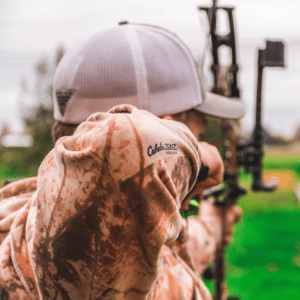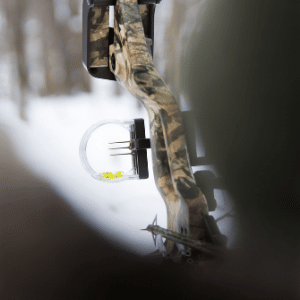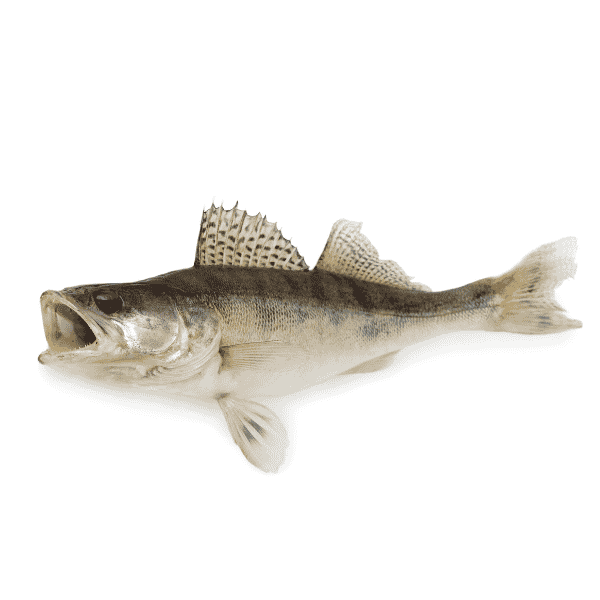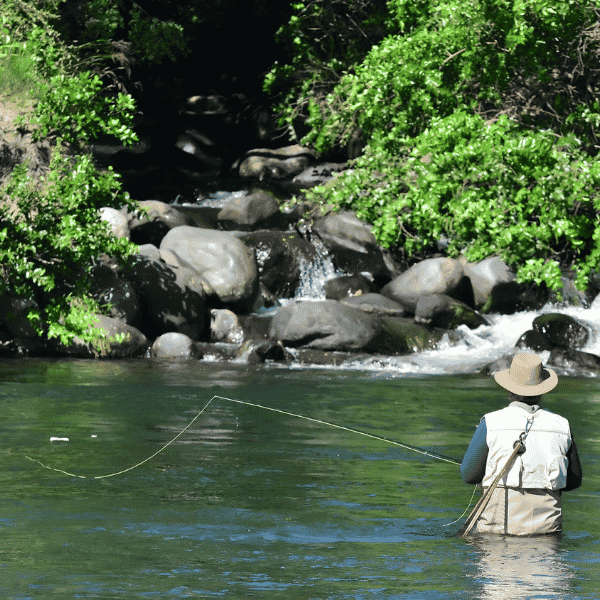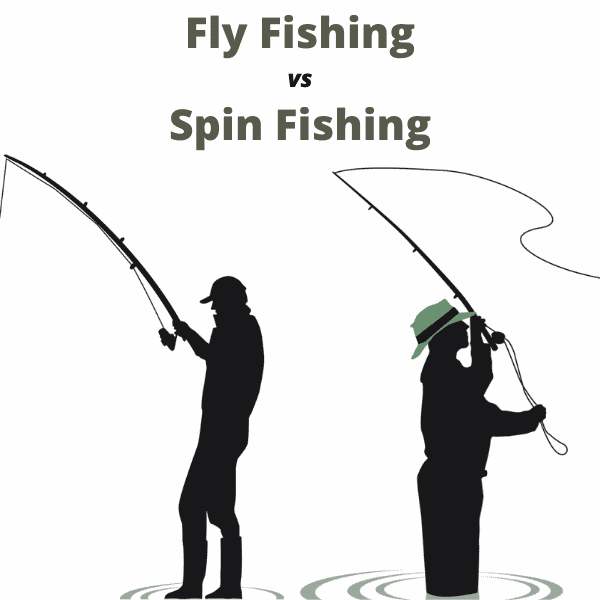Complete Guide To Fly Fishing For Beginners
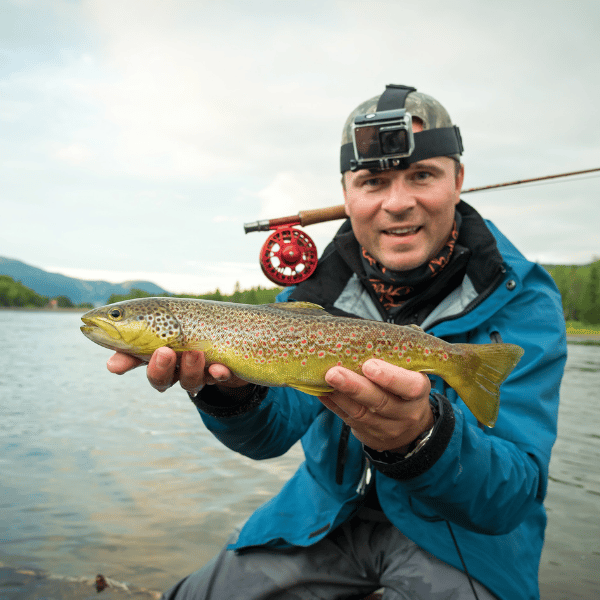
We created this complete guide to fly fishing for beginners for those considering fly fishing but have never done it before.
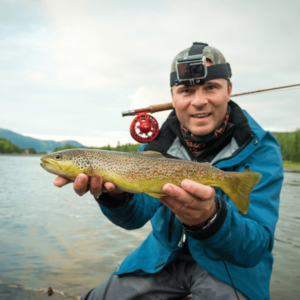
The following is a detailed guide on how to start fly fishing so you can be able to catch more fish using a method that may look a bit more challenging than the usual cast and reel method.
You will learn the basics of fly fishing and the kind of advantages it can have over other types of fishing. You will also learn about the kind of gear you’ll need so you know what fly fishing gear is needed for fly fishing before you cast your first line.
We’ll wrap this up with some beginner fly fishing techniques that will teach you the basics of how to catch fish fly fishing.
Contents
Basics of Fly Fishing for Beginners
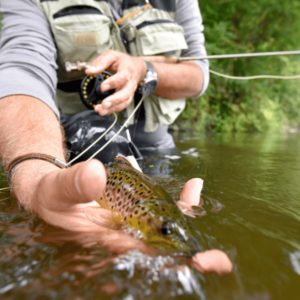
First off, fly fishing is a lot different compared to other types of fishing. When you watch it in action, it can be a bit intimidating even for the newbie.
In this section, you’ll learn some of the basics of fly fishing such as casting and baiting. Once you get the hang of it, it will be quite easy.
Let’s first take a look at the basic way to set up for fly fishing.
First and foremost, it’s all about selecting the right kind of rod for fly fishing. Most basic fly rods are nine feet in length.
To start, you want something that is anywhere between a 4 to 6 weight. This is the kind of rod that you’ll need for fish like trout and small-mouthed bass.
Next, you’re going to need your reel. Since you’ll be using a 4 to 6 weight rod to start, a ¾ reel will do the trick. Keep in mind that the larger the rod is going to be, the reel will be a lot more important.
Smaller rods won’t use a lot of reel drag, however. Most of the time, you’ll be reeling in the fish and dragging the rest of the line by hand.
You’ll also need backing aside from your usual line. In this instance, a 100 yard spool with a capacity of 20 to 30 pounds will work best for you.
Since you’ll be using a 4 to 6 weight line in this example, you’re going to use 50 yards of backing along with the fly line on your reel. Next, you’ll need your leaders and tippets.
Your leader should be 7.5 feet and made from 4x or 5x nylon. Your tippet spool (5x) will usually be 30 yards.
Lastly, you’ll need your flies and combination clippers. We’ll talk more about fly fishing gear later on in our overview.
You can also check out our 15 Best Fly Fishing Gear Essentials for Beginners.
Advantages Of Fly Fishing Over Other Types Of Fishing
So what are the advantages of fly fishing compared to the other types? You’ll actually be surprised that fly fishing might be a little better than other types of fishing.
Here are some of the advantages you can enjoy over types like spin casting:
- Lighter weight gear: Most of the gear you will be used in fly fishing will be lighter in weight. Lighter lines, lighter baits, and lures, everything will be lightweight. Spin casting will require gear to be heavier in weight. Using lighter-weight equipment might be more comfortable for you physically.
- Easier on moving water: One of the greatest challenges with spin casting is that it will be hard to do when working with fast-moving waters. It will be a lot easier to do when you are fly fishing.
- Easier personalization: When you are fly fishing, you can easily personalize your rod by using the best types of gear. Not to mention, you can switch things up if you’re in the mood to catch a certain type of fish.
- Better chances of catching fish: Whether it’s trout, bass, or pike, you may have an easier time catching these kinds of fish. Not to mention, a lot of the fish you want to catch will most likely be responsive to moving bait compared to bait that is standing around. Fly fishing does require you to move a bit, thus making it fun to do when it’s the catcher vs the catch.
Types Of Fish To Catch Fly Fishing
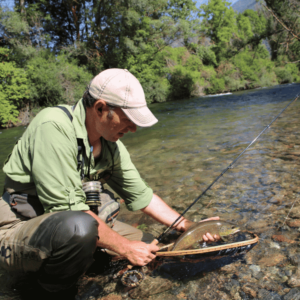
So what are the types of fish that you can catch while fly fishing? There are plenty of species to choose from.
The good news is that you can catch both freshwater and saltwater fish using this method. But since you are a beginner, we’ll stick to freshwater for the time being.
Here are some species of fish that you can catch fly fishing (depending on your location):
- Rainbow trout
- Salmon
- Small-mouthed bass
- Pike
- Black bass
- Shad
- Chubb
- Shadow bass
- Carp
This list is a sample of what you can catch in rivers and streams. Once you move out into saltwater, you can catch species like bonefish and tarpon.
Because of the numerous species available in freshwaters, you might find that fly fishing in rivers is way better than bays and oceans.
Fly Fishing Gear Overview For Beginners
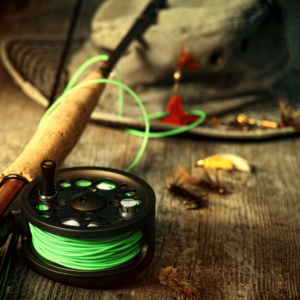
In this section, we will be talking about each piece of gear that you will be using for fly fishing. We will be explaining the purpose of each and why it’s important.
Here is a list of gear that you will need for a successful day of fly fishing:
Fly Rod
Obviously, you can fish without a rod. But it’s a matter of what kind of weight the rod will need to be. If you are catching regular freshwater fish like bass and trout, a 4 to 6 weight rod will get the job done. If you are planning on fishing in rivers, this will likely be the best rod of choice.
Fly Line
This is one of four parts of the fly line that we’ll be looking at. The first is the line itself. The momentum that you use will be centered around the fly line. The line itself will also cover a majority of the overall mass. A floating or sinking tip will work well regardless of the kind of fish you’re planning on catching.
Tippet
This piece of the line is a small, clear part of the line that will be useful when you plan on using multiple lines. You attach the tippet to the leader and it is difficult for fish to see. If you are planning on catching larger and heavier fish, you’ll need thicker and stronger tippets.
Leaders
This acts as the bridge between the tippet and the thick line. The leader will thin out and resemble the tippet of your line. Like the tippet, it’s thin and hard to see.
Backing
The backing is hidden inside the line itself. This will work to your advantage when you are running low on the original line.
Check out our 15 Best Fly Fishing Gear Essentials for Beginners, which outlines the best beginner fly fishing gear to get you started.
Beginner Fly Fishing Technique
When you watch someone fly fish, it’s a technique that is much different compared to spin cast fishing. The swinging back and forth is mesmerizing to say the least.
But how does one pull this off? This section will show you how.
Assuming you have your lines tied and your rod set up, now it’s time to perform this technique that is actually easy and fun to do. Here’s how you fly fish:
- Extend the line: Pull out some line in which you have enough length to cast it out into the water. Pull it on through the rod itself. There will be some loose line that is hanging from the bottom of your rod. This is fine since you’ll be using it as some kind of handle or guide for your line when you’re hauling in the fish.
- Grip the rod: Keep the rod holding steady. Then, you’ll need to load it up with weight by moving it back and forth. Once you feel like it’s loading up with weight, go in the reverse direction and move the line forward.
The video below details out a beginner step-by-step fly fishing technique very well.
Beginner Fly Fishing FAQ
With fly fishing, you are basically tricking the fish to catch an artificial fly. Plus, the movements make it a lot more natural compared to spin casting.
For the most part, you can fly fish just about anywhere that you can find fish in the first place. It truly all just depends on the type of fish that you are hoping to catch. You can easily look for spots online.
Yes, you can fly fish with a regular pole. However, you will need to make a few modifications. This includes the addition of lead weights and a casting bubble. Keep in mind that a spinning rod is not properly designed to cast unweighted flies at farther distances.
A fly fishing rod is required for fly fishing. Fly fishing rods are different than your traditional fishing rod. This is because fly rods can bend much more than regular rods. Also, a fly reel allowing for easier flow of the line is required.
Yes, there is a learning curve compared to regular fishing. However, with some practice and learning basic rig set-up and casting, it can be more exciting and fun compared to regular fishing.
Basic fly fishing gear for beginners does not need If you are choosing to purchase higher-end equipment such as rods, lines, and flies it can be expensive. You may be looking at costs ranging from $400 to $500 in total.
Check out our 15 Best Fly Fishing Gear Essentials for Beginners, which outlines the best value fly fishing items based on cost and quality.
Unless you are planning on getting into the water, you will not need to use waders in order to fly fish. However, if you do end up deciding to get some, be sure you purchase ones that will last.
For one, be aware of the type of soles used with the wader’s shoes or boots. When it comes to the soles of fly fishing boots, a felt sole can be ideal for gripping onto rocks, while a rubber sole is better for sandy or muddy waters.
When getting a fly, you have three options: dry flies, nymphs and streamers. The type of fly that you get all depends on the type of rod that you have as well as where you are fishing.
